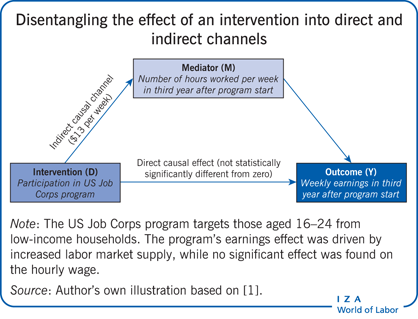Elevator pitch
Policy evaluation aims at assessing the causal effect of an intervention (for example job-seeker counseling) on a specific outcome (for example employment). Frequently, the causal channels through which an effect materializes can be important when forming policy advice. For instance, it is essential to know whether counseling affects employment through training programs, sanctions, job search assistance, or other dimensions, in order to design an optimal counseling process. So-called “mediation analysis” is concerned with disentangling causal effects into various causal channels to assess their respective importance.
Key findings
Pros
Mediation analysis of a particular policy effect gives a better understanding of why specific policy interventions are effective or ineffective.
Mediation analysis directed at a policy effect’s causal channels is likely to result in better policy advice, particularly with respect to the optimal design of the various components of a policy intervention.
Analyzing causal channels helps to understand the aspects of an intervention whose effectiveness appears particularly interesting (i.e. more relevant than that of other aspects).
Cons
Analyzing causal channels requires stronger behavioral (or identifying) assumptions than evaluating the “conventional” (total) causal effect of a policy intervention.
Sufficiently rich data, which plausibly justify key behavioral assumptions, are needed to analyze causal channels; panel data are typically required in these cases, but are not always available.
